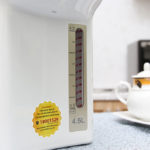Electric kettles are a common household appliance, offering a quick and convenient way to boil water. Over time, these kettles can develop electrical issues and stop working. If your kettle is not turning on, it might be due to a dirty electrical connection, affecting its conductivity.
To fix this, you’ll need a cotton swab. Dip it in alcohol or strong liquor, and thoroughly clean the kettle’s base, paying close attention to the gaps and crevices where dust and dirt tend to accumulate.

Using a Cotton Swab on the Kettle
As shown in the image, the cotton swab helps reach and clean the tight spaces effectively.

Cleaning the Base

No More Dust in the Crevices
Finally, wipe down the “copper plate” on the base. If your electric kettle isn’t turning on, remember to give it a good cleaning using this method.
Tips for Energy-Efficient Use of Your Electric Kettle
Avoid Continuous Boiling for Extended Periods
Give your kettle some rest between boils. When the water boils, unplug the kettle and let it cool down for about 15 minutes before plugging it in again for the next boil.
Always Keep the Lid Closed During Boiling
An electric kettle functions optimally and safely only when the lid is securely closed. Leaving the lid open leads to increased energy consumption and poses a safety hazard as boiling water may splash out, causing electrical faults or even fires.
Don’t Use the Kettle in Air-Conditioned Rooms or Near Fans
Operating the kettle in an air-conditioned room or near a fan will increase energy consumption. Instead, use it in a well-ventilated, cool, and dry area, away from any direct cooling sources.
Important Safety Precautions When Using an Electric Kettle
– Always fill the kettle to the recommended water level, neither overfilling nor underfilling it.
– Never pull the plug out by the cord. Always hold the plug itself to avoid the risk of electric shock due to exposed wires.
– Ensure your hands are dry when plugging in the kettle.
– Do not use the kettle for cooking or heating food.
– Keep the lid closed during operation.
– Regularly clean and maintain your electric kettle.
– Do not move the kettle while it is in use.



































